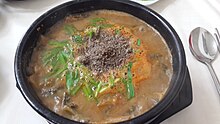Chueo-tang (Korean: 추어탕) or loach soup[1] is a Korean tang (soup) that prominently features pond loach, a freshwater fish.[2][3] The city of Namwon in southwestern South Korea is known for its version of the dish.[4][5][6]
 Chueo-tang served with perilla seed powder | |
| Alternative names | Loach soup |
|---|---|
| Type | Tang |
| Place of origin | Korea |
| Associated cuisine | Korean cuisine |
| Main ingredients | Pond loach |
| Korean name | |
| Hangul | 추어탕 |
|---|---|
| Hanja | 鰍魚湯 |
| Revised Romanization | chueo-tang |
| McCune–Reischauer | ch'uŏ-t'ang |
| IPA | [tɕʰu.ʌ.tʰaŋ] |
Etymology
editChueo (추어; 鰍魚) is a nickname for pond loach, called mikkuraji (미꾸라지) in Korean. Tang (탕; 湯) means soup.
History and tradition
editAs irrigated rice paddies are drained after chubun (autumnal equinox), chubby pond loaches, ready for hibernation, are easily caught in the ditches dug around paddy fields.[7] Chueo-tang (추어탕) is often a featured dish in banquets for the elderly.[7]
In Hanyang (now Seoul) during the Joseon era, the guild of licensed panhandlers mandated that its members beg only for bap (cooked rice), not banchan (side dishes) or guk (soup).[7] (The practice was intended to maintain dignity and differentiate members from unlicensed beggars.) As an accompaniment to the rice, Panhandlers hunted pond loaches and made chueo-tang. They were also granted the exclusive rights to sell chueo-tang in the city.[7]
The third-oldest operating restaurant in Seoul, Yonggeumok,[8] specializes in the Seoul style of the dish. In the Seoul style, the fish are served whole, and the soup base uses chili pepper flakes instead of gochujang.[9]
Preparation
editPond loaches are boiled in water until very tender, and sieved to remove bones and skins.[10] The sieved flesh along with beef or chicken broth is then boiled again and seasoned with gochujang (chili paste), doenjang (soybean paste), grated ginger, and ground black pepper.[10] Vegetable ingredients include mung bean sprouts, Asian royal fern, scallions, napa cabbages, and mustard greens.[10] The soup is often served with ground chopi peppercorns, along with Korean mint leaves (in Yeongnam region) or perilla powder (in Honam region).[11]
See also
edit- Dojō nabe, Japanese pond loach stew
- List of soups
References
edit- ^ "Loach Soup Recipe". Simple Chinese Food. 2021-09-17.
- ^ "주요 한식명(200개) 로마자 표기 및 번역(영, 중, 일) 표준안" (PDF). National Institute of Korean Language (in Korean). 30 July 2014. Retrieved 16 February 2017.
- 주요 한식명 로마자 표기 및 표준 번역 확정안 공지. National Institute of Korean Language (Press release) (in Korean). 2014-05-02.
- ^ Jeon, Yuri (19 July 2016). "Top 10 Korean Delicacies to Battle the Heat". 10 Magazine. Retrieved 17 May 2017.
- ^ Crawford, Matthew (6 January 2017). "Take It Slow In The Historic City Of Namwon". 10 Magazine. Retrieved 17 May 2017.
- ^ Choi, He-suk (17 July 2013). "Soaking in history and culture along the Jirisan trail". The Korea Herald. Retrieved 17 May 2017.
- ^ Kim, Rahn (21 May 2015). "'Tasty roads'". The Korea Times. Retrieved 17 May 2017.
- ^ a b c d Han, Bok Jin (2005). "Chueo-tang" 추어탕. Uri eumsik baek gaji 1 우리 음식 백가지 1 [One Hundred Essential Korean Dishes Vol. 1] (in Korean). Hyeonamsa. ISBN 89-323-1291-5 – via Naver.
- ^ "오래 사랑받은 노포들, 서울미래유산 속 식당 50". mediahub.seoul.go.kr (in Korean). Seoul Metropolitan Government. 2021-11-11. Retrieved 2024-08-01.
- ^ 김, 성환 (2022-05-28). "추탕 외길 90년 용금옥…코로나 한파 뚫고 진짜 '100년 가게'로". Hankook Ilbo (in Korean). Retrieved 2024-08-01.
- ^ a b c "chueo-tang" 추어탕. Doopedia (in Korean). Doosan Corporation. Retrieved 17 May 2017.
- ^ Hansen, Barbara (28 May 2014). "Chueotang, the Korean Soup That Will Make You Gorgeous, Even If It's Not". LA Weekly. Retrieved 17 May 2017.